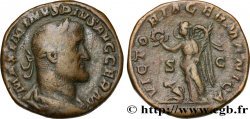Obverse
Obverse legend : REPUBLIQUE FRANÇAISE..
Obverse description : Tête de la République aux cheveux longs à gauche, drapée et coiffée d'un bonnet phrygien ; au-dessous Dupré en cursif.
Reverse
Reverse description : En deux lignes dans le champ, au-dessus le millésime suivi d'un point et de la lettre d'atelier encadrés des différents, dans une couronne fermée composée de deux branches de chêne opposées nouées à leur base par un ruban.
Historical background
DIRECTOIRE
(26/10/1795-9-10/11/1799)
When the Convention separated on October 25, 1795, a new executive power provided for by the Thermidorian constitution was put in place.. This constitution plans to entrust power to a board of five members, each of whom presides in turn, with the replacement of one member every two years.. This board appoints ministers and civil servants, directs foreign policy and enforces laws, but it does not draft them and has no control over public funds.. Power is shared with two chambers: the Council of Five Hundred and the Council of Elders which form the Legislative Body.. This power is determined to maintain itself in the face of the risk of a monarchical restoration or a Jacobin reaction, but it is above all paralyzed by the financial crisis and must give up the assignat in 1796.. The replacement of the assignats by the territorial mandates does not inspire more confidence and this new fiduciary coin is abolished in 1797. Faced with misery and attempts at destabilization, the Directory, accused of being a "bourgeois republic", returned to revolutionary and police measures. Moreover, since 1792, the war has been uninterrupted and the influence of military leaders is growing.. In 1799, the supporters of a strong power, including Sieyès, found themselves in the Directory and they opened the way to power for Bonaparte, back from Egypt.. The coup of 18 and 19 brumaire year VIII allows the establishment of a military dictatorship under the name of Consulate.










 Report a mistake
Report a mistake Print the page
Print the page Share my selection
Share my selection Ask a question
Ask a question Consign / sell
Consign / sell
 Full data
Full data















